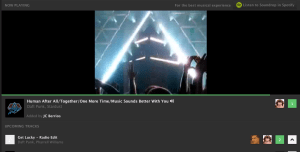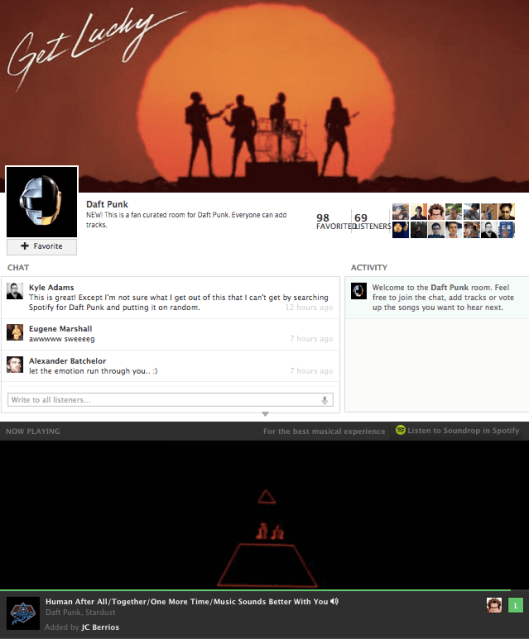Soundrop, the popular social and interactive “listening room” music service that first launched as an app on Spotify, continues to branch out and become ever-more ubiquitous. The latest iteration: a new web version, now out in beta, which lets users tap into existing listening rooms based on artists, genres and moods, using Spotify’s move to the web as a way of building out part of the audio component, and synchronising those tracks with videos from YouTube. The web app is the latest product in a series that also includes a Spotify app and the ability to access rooms via Facebook embeds.
 While Spotify is now available in 28 markets (after adding its first territories in Asia and Latin America earlier in April), Soundrop’s web app is global: wherever Spotify does not work, Soundrop reverts to searching and using tracks posted on YouTube and Vevo.
While Spotify is now available in 28 markets (after adding its first territories in Asia and Latin America earlier in April), Soundrop’s web app is global: wherever Spotify does not work, Soundrop reverts to searching and using tracks posted on YouTube and Vevo.
Co-founder and CEO Inge-Andre Sandvik points out that this is not about creating a competing service for Spotify itself on the web. Instead, what it does is introduce both Soundrop’s platform, and the music services it aggregates, to a different audience.
“This is not competing. It’s more targeted to all the YouTube users out there that now can get curated playlists, and piggy back on all the great curation from all the Spotify users,” he notes. In the corner of every playlist, Soundrop also gives a link to Spotify itself, encouraging people to download its desktop app.
It’s also a way of significantly widening the community of both Soundrop and Spotify users. Those who tap into the web version synchronise not only with those using Soundrop’s Spotify app (first launched last year) but its Facebook app, which debuted in January, when Soundrop first showed off its audio/video synching capabilites, to create a cross-platform community that brings all the listeners together. While Soundrop used to also offer standalone mobile apps, for now those have been pulled while they get rebuilt on the company’s new Erlang-based platform first launched in October.
Still, the plan, Sandvik says, is to go beyond Spotify to add more music streams to the service as well. This makes Soundrop not unlike what Twitter music is doing in aggregating different services into its own trending/discovery Twitter #Music service. It is also reminiscent of the “roaming network for subscription music services” that Fred Wilson recently described on his blog.
As with the Facebook app, the new web app doesn’t appear to allow users to create their own listening rooms, just tap into those that have been made already, and add their own tracks to them. That service is still exclusive to Soundrop’s Spotify app, although it’s likely this will eventually become a feature elsewhere. More immediately, Sandvik says Soundrop will soon be introducing a way to “collect” music from the web player and add it to your own Spotify music library to listen to whenever you want.
Soundrop, as we pointed out when it raised $3 million last year, with backing from early Spotify investor Northzone, has been exploring a number of different business models. The service itself is free to use, but it collects revenue shares from labels on the traffic that Soundrop brings to their artists; and it also has been building out the ability to create customized rooms and apps. These are sold primary through in-direct channels, such as Spotify’s ad sales team and digital agencies. (The latter was responsible for the first customized app to launch on Soundrop’s platform, a “music room” the DJ David Guetta.)
Meanwhile, Oslo-based Soundrop also continues to grow in other ways and is still working on its next round of investment, which will like involve strategic partners.
